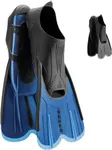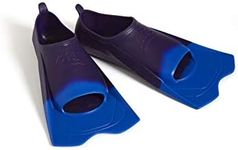Buying Guide for the Best Kids Swim Fins
Choosing the right swim fins for kids can greatly enhance their swimming experience, whether they're just learning to swim or are already comfortable in the water. Swim fins help improve swimming technique, build leg strength, and increase speed in the water. When selecting swim fins for kids, it's important to consider factors such as comfort, size, and the intended use. The right pair of fins should fit well, be comfortable to wear for extended periods, and suit the child's swimming level and goals.Size and FitSize and fit are crucial when selecting swim fins for kids. A proper fit ensures comfort and effectiveness in the water. Swim fins that are too tight can cause discomfort and blisters, while fins that are too loose can slip off during swimming. To find the right size, measure the child's foot and refer to the manufacturer's sizing chart. It's important to try the fins on, if possible, to ensure they fit snugly without pinching. Consider the child's growth and opt for adjustable fins if they are between sizes or expected to grow quickly.
MaterialSwim fins are typically made from rubber or silicone. Rubber fins are durable and provide a firm fit, making them ideal for rigorous training. Silicone fins, on the other hand, are softer and more flexible, offering greater comfort, which is beneficial for beginners or younger children. When choosing the material, consider the child's comfort level and any skin sensitivities. If the child is new to swimming, silicone fins might be a better choice due to their comfort, while more experienced swimmers might prefer the durability of rubber fins.
Blade LengthThe blade length of swim fins affects the swimmer's speed and the level of resistance they experience. Short blade fins are ideal for beginners and young swimmers as they provide a more natural kick and are easier to control, helping to improve technique. Long blade fins offer more resistance and are better suited for building leg strength and speed, making them suitable for more advanced swimmers. Consider the child's swimming ability and goals when choosing the blade length. For general swimming and learning, short blades are often the best choice.
BuoyancyBuoyancy in swim fins can help with floatation and maintaining proper body position in the water. Some fins are designed to be more buoyant, which can be beneficial for beginners who need extra support. Less buoyant fins allow for a more natural swimming experience and are often preferred by more experienced swimmers. When selecting fins, consider the child's swimming proficiency and whether they need additional support in the water. Beginners may benefit from more buoyant fins, while those who are comfortable in the water might prefer less buoyancy.
Heel DesignThe heel design of swim fins can be either open or closed. Open heel fins are adjustable and can accommodate growth, making them a good choice for children who are still growing. They also allow for better ventilation and are easier to put on and take off. Closed heel fins provide a more secure fit and are often more comfortable for extended use. When choosing between open and closed heel designs, consider the child's comfort, ease of use, and whether they will be sharing the fins with others or need room for growth.
















